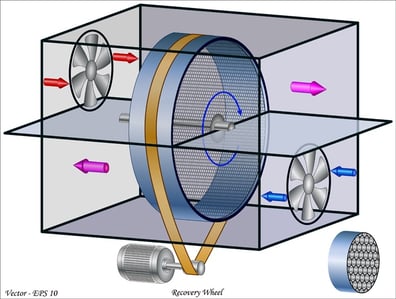ERV HVAC: How HVAC Engineers Use Energy Recovery Ventilation

Energy recovery ventilation (ERV) is one of the most useful energy efficiency measures in HVAC engineering. As we know, a large portion of heating and cooling provided to indoor spaces is exhausted to the outdoor environment and wasted. This happens not only at the air exhaust, but also through bathroom vents and trash exhaust. The purpose of ERV is recovering some of the energy contained in the airstream that leaves an indoor area.
ERV systems achieve savings during both summer and winter, while improving humidity control for indoor spaces. Since they reduce the workload on heating and cooling system, they often allow the use of smaller equipment, reducing capital expenses. Finally, since ERV systems reduce the use of external energy inputs, they have a fundamental role in passive house design.
Improve your HVAC efficiency with energy recovery ventilation.
How Does ERV Work?
An energy recovery ventilator uses HVAC exhaust air to precondition the supply air, which enters the building at outdoor temperature and humidity. This process recovers some of the heating or cooling output that would otherwise be lost.
-
During summer, the ERV system can pre-cool and dehumidify the outdoor air supply, by exchanging energy with the cooler and drier exhaust air.
-
During winter, the ERV system preheats the air supply, extracting heat from the warmer exhaust air.
-
ERV reduces the electricity consumption of HVAC systems, while improving indoor air quality.
ERV is based on air-to-air heat exchange, using a spinning wheel or a stationary core where airstreams can exchange energy without mixing. Since every device is limited by the laws of thermodynamics, an ERV system cannot achieve 100% energy recovery. The effectiveness of ERV units is certified by AHRI, and it changes based on environmental conditions - performance is normally defined separately for summer conditions and winter conditions.

Understanding Sensible and Latent Heat in ERV Systems
To get a clear picture of how an ERV system operates, it is important to understand the difference between sensible and latent heat. Sensible heat is involved in temperature changes, while latent heat is involved in phase changes such as water evaporation. An ERV system can be designed to exchange only sensible heat, or both.
-
An ERV system that exchanges only sensible heat preheats or pre-cools the air intake depending on the season, but without humidity exchange.
-
An ERV system that exchanges both latent and sensible heat can use the exhaust air to humidify or dehumidify the supply air.
For example, an ERV system that exchanges both sensible and latent heat can remove humidity from outdoor air before it reaches air conditioning equipment. In other words, humidity from the air supply is transferred to the exhaust airstream.
-
Without ERV, the air conditioning system must handle the full cooling load and dehumidification load.
-
However, the ERV system can reduce both loads simultaneously.
In new constructions, using ERV from the start may allow HVAC engineers to downsize the tonnage of air conditioning systems. This reduces not only their energy consumption, but also their upfront cost. ERV operation is reversed during winter, but the benefit is the similar: the unit reduces the total heating output required from furnaces or boilers.
ERV systems lead to more moderate load conditions on HVAC equipment during the entire year. In particular, they mitigate the highest cooling loads on hot summer days, and the highest heating loads on the coldest days of winter.
ERV Systems and Code Compliance
Like many other additions for HVAC installations, energy recovery ventilation is subject to building code requirements. Also note that not all weather and building conditions are suitable for ERV, and the investment may not be justified under some circumstances.
-
In the case of New York City, the Energy Conservation Code covers ERV systems in section C403.2.7.
-
ERV systems must also meet the ASHRAE 62.1 and 62.2 requirements for ventilation and indoor air quality.
HVAC engineers can specify the most suitable ERV system according to your building needs and local weather conditions. They are also familiarized with code requirements and can help you get a quick project approval.
Make sure your mechanical installations are code compliant and energy efficient, while getting a 50% faster turnaround. You can contact Nearby EngineersNew York Engineers by email (info@ny-engineers.com) or phone (786) 788-0295212-575-5300.

Anuj Srivastava
Anuj Srivastava is a principal partner at NY Engineers. He is known for his MEP franchise market knowledge. Anuj is currently leading a team of 100+ MEP/FP engineers and has successfully led over 1500 franchise projects in the US.
Join 15,000+ Fellow Architects and Contractors
Get expert engineering tips straight to your inbox. Subscribe to the NY Engineers Blog below.

